
The Four Thirds System is a standard created by Olympus and Eastman Kodak for digital single-lens reflex camera (DSLR) and mirrorless camera design and development.

A fisheye lens is an ultra wide-angle lens that produces strong visual distortion intended to create a wide panoramic or hemispherical image. Fisheye lenses achieve extremely wide angles of view. Instead of producing images with straight lines of perspective, fisheye lenses use a special mapping, which gives images a characteristic convex non-rectilinear appearance.

Macro photography is extreme close-up photography, usually of very small subjects and living organisms like insects, in which the size of the subject in the photograph is greater than life size . By the original definition, a macro photograph is one in which the size of the subject on the negative or image sensor is life size or greater. In some senses, however, it refers to a finished photograph of a subject that is greater than life size.

A digital single-lens reflex camera is a digital camera that combines the optics and the mechanisms of a single-lens reflex camera with a digital imaging sensor.

The Nikon F-mount is a type of interchangeable lens mount developed by Nikon for its 35mm format single-lens reflex cameras. The F-mount was first introduced on the Nikon F camera in 1958, and features a three-lug bayonet mount with a 44 mm throat and a flange to focal plane distance of 46.5 mm. The company continues, with the 2020 D6 model, to use variations of the same lens mount specification for its film and digital SLR cameras.
The Olympus OM System was a line of 35mm single-lens reflex cameras, lenses and accessories sold by Olympus between 1972 and 2002. The system was introduced by Olympus in 1972. The range was designed by Yoshihisa Maitani, chief designer for Olympus, and his staff; OM stands for Olympus Maitani.
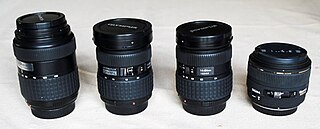
This article is about photographic lenses for single-lens reflex film cameras (SLRs) and digital single-lens reflex cameras (DSLRs). Emphasis is on modern lenses for 35 mm film SLRs and for DSLRs with sensor sizes less than or equal to 35 mm ("full-frame").
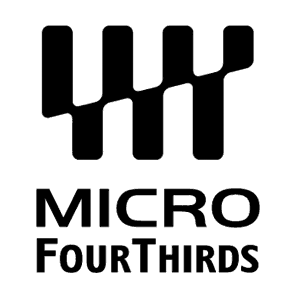
The Micro Four Thirds system is a standard released by Olympus and Panasonic in 2008, for the design and development of mirrorless interchangeable lens digital cameras, camcorders and lenses. Camera bodies are available from Blackmagic, DJI, JVC, Kodak, Olympus, Panasonic, Sharp, and Xiaomi. MFT lenses are produced by Cosina Voigtländer, DJI, Kowa, Kodak, Mitakon, Olympus, Panasonic, Samyang, Sharp, Sigma, SLR Magic, Tamron, Tokina, TTArtisan, Veydra, Xiaomi, Laowa, Yongnuo, Zonlai, Lensbaby, Kowa and 7artisans amongst others.
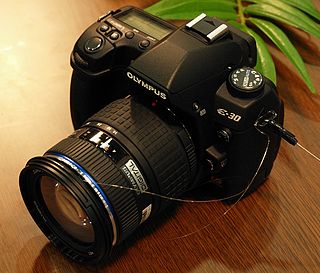
The Zuiko Digital 14–54 mm f/2.8–3.5 II is a Four Thirds System Pro series lens by Olympus Corporation, sold in a kit with the Olympus E-30 camera body and available separately. It is positioned just below the Olympus Zuiko Digital ED 12–60mm 1:2.8–4 SWD in terms of size, weight, focusing speed, price and focal length range, while having larger apertures. It replaces the Olympus Zuiko Digital 14–54mm 1:2.8–3.5, which had a longer minimum focusing distance.

The Olympus Pen E-P1 announced on 16 June 2009 is Olympus Corporation's first camera that adheres to the Micro Four Thirds (MFT) system design standard. The first camera to use the Micro Four Thirds mount was Panasonic's G-1 camera.
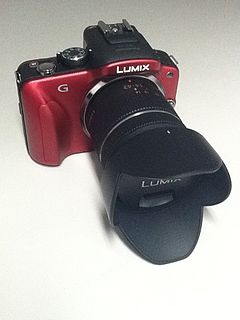
The Panasonic Lumix DMC-G3 is a digital mirrorless interchangeable lens camera adhering to the joint Olympus and Panasonic Micro Four Thirds System (MFT) system design standard. The Panasonic Lumix DMC-G3 is the eighth Panasonic MFT camera introduced under the standard and the thirteenth model MFT camera introduced by either Olympus or Panasonic, as of the G3 product announcement date.

The Panasonic Lumix DMC-G2 is a digital mirrorless interchangeable lens camera adhering to the Olympus and Panasonic developed Micro Four Thirds System (MFT) system design standard. It was announced in March 2010 along with a lesser featured Panasonic Lumix DMC-G10.
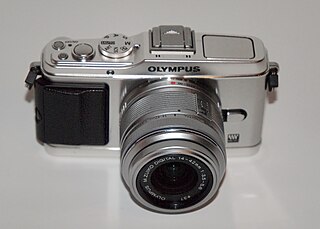
The Olympus PEN E-P3 announced on 30 June 2011 is Olympus Corporation's seventh camera that adheres to the Micro Four Thirds (MFT) system design standard. The E-P3 succeeds the Olympus PEN E-P2, and was announced in concert with two other models, the Olympus PEN E-PL3, and the Olympus PEN E-PM1.
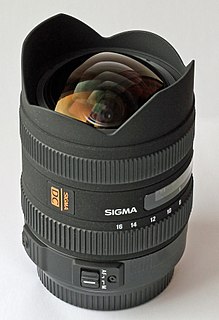
The Sigma 8–16mm lens is an enthusiast-level, ultra wide-angle rectilinear zoom lens made by Sigma Corporation specifically for use with APS-C small format digital SLRs. It is the first ultrawide rectilinear zoom lens with a minimum focal length of 8 mm, designed specifically for APS-C size image sensors. The lens was introduced at the February 2010 Photo Marketing Association International Convention and Trade Show. At its release it was the widest viewing angle focal length available commercially for APS-C cameras. It is part of Sigma's DC line of lenses, meaning it was designed to have an image circle tailored to work with APS-C format cameras. The lens has a constant length regardless of optical zoom and focus with inner lens tube elements responding to these parameters. The lens has hypersonic zoom autofocus.
Zuiko is a brand of optical lenses made by Olympus Corporation that was used up to and into the Four Thirds system era. The name Zuiko (瑞光) means 'Light of the Gods', using a character from the Mizuho Optic Research Laboratory (瑞穂光学研究所), where the lens was developed, and a character from Takachiho Corporation (高千穂製作所), which would eventually become the Olympus Corporation.
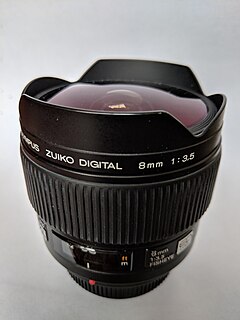
The Olympus Zuiko Digital ED 8mm f/3.5 Fisheye is an interchangeable "full-frame" or diagonal fisheye lens for Four Thirds system digital single-lens reflex cameras, announced by Olympus Corporation on June 30, 2005.
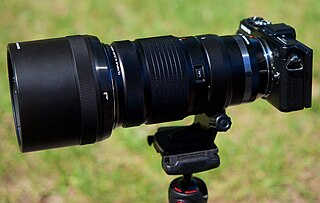
The M.Zuiko Digital ED 40–150mm f/2.8 PRO is a professional telephoto zoom lens made by Olympus for the Micro Four Thirds system. It is the first telephoto lens in the Olympus M.Zuiko PRO range, which features weather-sealed, metal construction and high-performance optics intended to accompany the higher-end weather-sealed Olympus OM-D bodies such as the E-M1 Mark II. The lens features an integrated lens function button and manual-focus clutch, and ships with a tripod collar and collapsible lens hood.

Olympus M.Zuiko Digital ED 300 mm f/4 IS Pro is an optically corrected telephoto lens. With its extreme focal length of 300 millimetres it is the refracting prime lens with the longest focal length of the Micro Four Thirds system.

The Panasonic Leica DG Vario-Elmarit 8–18 mmf/2.8-f/4.0 lens is a digital compact ultra wide angle lens for Micro Four Thirds system cameras. It is a varifocal lens branded with the German label Leica, but manufactured by Panasonic in Japan.

The Zuiko Digital 14–54 mm f/2.8–3.5 is a Four Thirds System High Grade series lens by Olympus Corporation, initially sold in a kit with the Olympus E-1 camera body and also available separately. Three glass aspherical lenses are used in its optical formulation. It was positioned as an upgrade to the 14-45mm kit lens in terms of focal length range while having larger apertures. It was replaced as the premium kit lens by the Olympus Zuiko Digital ED 12-60mm f/2.8-4 SWD with the release of the E-3, and later was directly replaced by the Olympus Zuiko Digital 14-54mm f/2.8-3.5 II, which is more suited for mirror-up or mirrorless operation.

















